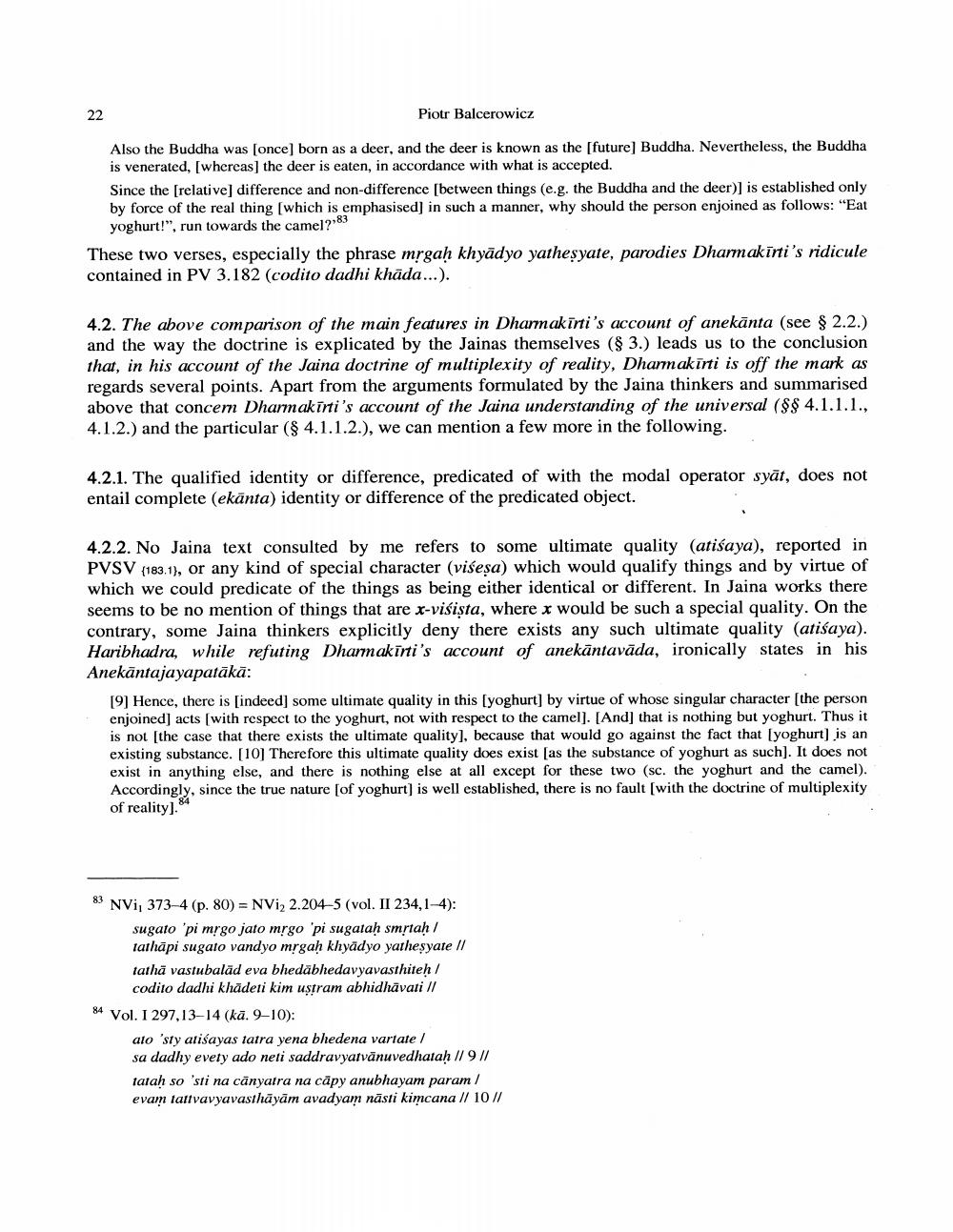________________
Piotr Balcerowicz
Also the Buddha was (once] born as a deer, and the deer is known as the [future] Buddha. Nevertheless, the Buddha is venerated, [whereas the deer is eaten, in accordance with what is accepted. Since the [relative difference and non-difference [between things (e.g. the Buddha and the deer)] is established only by force of the real thing (which is emphasised) in such a manner, why should the person enjoined as follows: "Eat
yoghurt!", run towards the camel?"83 These two verses, especially the phrase mrgaḥ khyādyo yathesyate, parodies Dharmakirti's ridicule contained in PV 3.182 (codito dadhi khāda...).
4.2. The above comparison of the main features in Dharmakirti's account of anekānta (see § 2.2.) and the way the doctrine is explicated by the Jainas themselves ( 3.) leads us to the conclusion that, in his account of the Jaina doctrine of multiplexity of reality, Dharmakīrti is off the mark as regards several points. Apart from the arguments formulated by the Jaina thinkers and summarised above that concern Dharmakirti's account of the Jaina understanding of the universal (88 4.1.1.1.. 4.1.2.) and the particular ($ 4.1.1.2.), we can mention a few more in the following.
4.2.1. The qualified identity or difference, predicated of with the modal operator syāt, does not entail complete (ekänta) identity or difference of the predicated object.
4.2.2. No Jaina text consulted by me refers to some ultimate quality (atiśaya)reported in PVSV (183.1), or any kind of special character (višeşa) which would qualify things and by virtue of which we could predicate of the things as being either identical or different. In Jaina works there seems to be no mention of things that are x-visişta, where x would be such a special quality. On the contrary, some Jaina thinkers explicitly deny there exists any such ultimate quality (atiśaya). Haribhadra, while refuting Dharmakirti's account of anekāntavāda, ironically states in his Anekāntajayapatākā:
[9] Hence, there is indeed) some ultimate quality in this [yoghurt) by virtue of whose singular character (the person enjoined) acts (with respect to the yoghurt, not with respect to the camel]. [And] that is nothing but yoghurt. Thus it is not [the case that there exists the ultimate quality], because that would go against the fact that (yoghurt) is an existing substance. [10] Therefore this ultimate quality does exist (as the substance of yoghurt as such). It does not exist in anything else, and there is nothing else at all except for these two (sc. the yoghurt and the camel). Accordingly, since the true nature [of yoghurt) is well established, there is no fault (with the doctrine of multiplexity of reality).
* NVI, 373-4 (p. 80) = NVi2 2.204-5 (vol. II 234, 1-4):
sugato 'pi mrgo jato mrgo 'pi sugatah smrtah/ tathāpi sugato vandyo mrgaḥ khyādyo yathesyate II tathā vastubalād eva bhedäbhedavyavasthiteh/
codito dadhi khäderi kim ustram abhidhävati // 84 Vol. I 297,13-14 (kā. 9-10):
alo 'sty alisayas tatra yena bhedena vartate / sa dadhy every ado neti saddravyarvänuvedhatah // 9 // fatah so 'sti na canyatra na cäpy anubhayam param/ evam tallvavyavasthāyām avadyam nästi kimcana // 10 //




